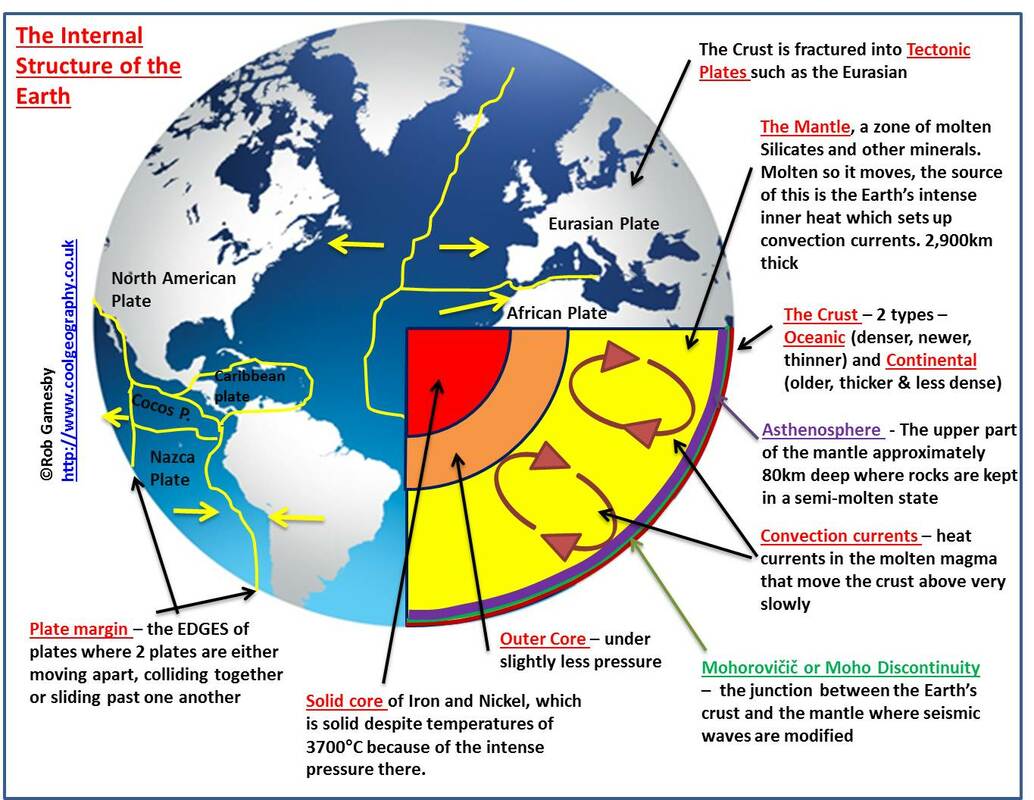Hey there! Let’s take a quick but exciting journey to the center of our planet, the Earth! 🌍
So, imagine the Earth is like a giant apple. The outer part is the skin, and as we go deeper, things get hotter and more intense. The Earth has different layers, each with its own cool characteristics.
Let’s break it down in a fun way:
- Crust (The Skin of the Earth):
- This is like the crust of a pizza, and it's where we live! It's thin compared to the other layers but super important. The crust is made up of land and ocean, and it’s where we find mountains, valleys, oceans, and continents.
- Mantle (The Gooey Middle):
- Just beneath the crust, things get a little crazy. The mantle is made up of hot, semi-solid rock. It’s kind of like a thick stew that slowly moves around. It’s also the layer where we find convection currents—which is basically hot rock that rises and cooler rock that sinks, kind of like stirring a pot.
- Outer Core (The Liquid Lava):
- Here, it gets really hot! The outer core is made of liquid iron and nickel. It’s so hot that metals melt into a liquid state, and that’s where we get Earth's magnetic field from!
- Inner Core (The Super Hot Center):
- Now we’ve reached the center of the Earth, and it’s super hot and made of solid iron and nickel. Imagine the Earth's heart—it’s so hot that even though it's under extreme pressure, it remains solid! It’s like a giant ball of metal, right in the middle of our planet.
How amazing is that? These layers all work together to help make our Earth the place we know and love. It’s like Earth is a big, layered cake, and we’re living on the top layer! 🍰
How cool is it that the Earth’s layers affect things like earthquakes, volcanoes, and even the weather? Alright! Now, let’s dive a bit deeper into the Earth and take a tour inside, layer by layer! 🌍🎉
Imagine this: The Earth is like a giant ball, and we're going to peel away its layers, kind of like how you peel an onion (but hopefully, no tears)! 😄 Ready? Let’s go!
1. The Crust - Our Earth’s Skin (The First Layer)
So, picture this: the Earth’s crust is like the skin of an apple 🍏 or the outer layer of a pizza crust 🍕. It’s super thin when compared to the other layers. In fact, if you could imagine the Earth as the size of a giant ball, the crust would only be about as thick as the skin of an apple. But it's super important because it’s where we live! 😊
The crust is made up of two parts:
- Oceanic Crust: This is found beneath the oceans, and it’s made of dense rocks like basalt.
- Continental Crust: This is the land we walk on! It's thicker than the oceanic crust and made up of lighter rocks like granite.
The crust is solid rock, and it includes the continents (land) and the oceans (water). You can think of it as Earth’s “outer shell” that we interact with every day—whether we're hiking a mountain, swimming in the sea, or driving to school.
2. The Mantle - The Earth's Gooey Middle (The Second Layer)
Alright, now we’re going deeper! 🕳️ After we pass through the crust, we enter the mantle. This layer is MUCH thicker than the crust. In fact, it makes up about 84% of the Earth’s volume! Think of it like a giant thick stew that’s hot and gooey. 😋
- The upper mantle is where things start to get interesting, because it’s semi-solid. That means it’s kind of like thick, sticky melted candy—you can’t just easily poke your finger through it, but it moves slowly.
- The lower mantle is hotter and more solid than the upper part, but it’s still capable of very slow movement. This is where we get convection currents, which are like a giant conveyor belt of rock that helps move the Earth's plates around! 🏞️
This movement causes earthquakes, volcanoes, and even mountain ranges! It's like the Earth's way of stretching and shifting. 🌋
3. The Core – The Heart of the Earth (The Third Layer)
Okay, now we’re reaching the deepest part—the core. This is where things get seriously intense. We’re talking super hot, almost crazy hot! 🔥
The core is split into two parts:
- Outer Core (Liquid): This part is made of liquid iron and nickel. It’s so hot, about 5,000–7,000°C (9,000–12,600°F)! This liquid metal is constantly moving, and this movement is what helps create the Earth’s magnetic field. Without the outer core, we wouldn’t have the magnetism that protects us from solar radiation!
- Inner Core (Solid): The very center of the Earth is solid iron and nickel. Even though it's unbelievably hot (around 5,500°C or 9,932°F), the pressure at the center is so high that the iron remains solid. It's like the Earth's heart—strong, solid, and beating with heat! 🔥❤️
So Why Is All This Important?
Each of these layers has an important job! The crust is where we live, the mantle is like the Earth’s moving machinery, and the core is the power center that drives everything beneath our feet. The Earth's movement, energy, and even life itself are all influenced by what's going on inside these layers!
It’s pretty awesome to think that our planet is alive and constantly changing, right? The layers are like the Earth’s “inner workings,” making it an active, dynamic place to live!
Doesn’t it make you look at the Earth differently now? I mean, it’s like this giant, super-powered ball full of hot metal, thick goo, and solid rock—all working together! 🌎🔥
How do you feel about all that heat and pressure down there? Pretty cool, right? 😎
1. The Crust – The Cake's Frosting (Top Layer)
The crust is the thin, outermost layer of the Earth, kind of like the frosting or outer icing on a cake. It’s smooth and where we live—just like how frosting is what you see and taste first when you eat a cake. It’s solid, a bit crunchy (like cookies!), and thin compared to the other layers. It covers the entire Earth and holds everything together—like how frosting holds the cake together and makes it look pretty! 🎨
The crust is made up of land and ocean, and it’s where all the fun things happen—mountains, oceans, and volcanoes. It’s the layer we interact with every day!
2. The Mantle – The Cake's Spongey Middle (Middle Layer)
Now, after we cut through the frosting (crust), we reach the mantle—and this is like the fluffy, soft, spongy part of the cake! 🧁
The mantle is thick and full of "fluff"—but not in the way you might think. It’s actually made up of hot, semi-solid rock that moves very slowly, kind of like a cake that’s been whipped and is now rising in the oven. The mantle is super thick compared to the crust, so if the crust is the frosting, the mantle is like the massive, soft cake filling beneath it. It’s here that the Earth's plates are moving, creating things like mountains, earthquakes, and volcanoes!
3. The Outer Core – The Cake’s Molten Chocolate Center (Liquid Layer)
If the Earth cake had a gooey, molten chocolate center, that would be the outer core! 🍫 Just like how you might find some warm, liquid fudge in the middle of a chocolate lava cake, the outer core is made of liquid iron and nickel, and it’s super hot! This layer is where the Earth's magnetic field comes from—kind of like how chocolate might ooze out and create a cool effect in a cake! 😋
The outer core is very hot, but it’s still not solid. Instead, it's flowing like melted chocolate—creating the energy and movement that makes the Earth’s magnetic field!
4. The Inner Core – The Solid Chocolate Core (Hard, Sweet Center)
Now, for the final layer: the inner core is the very center of the Earth, and it’s like the hard, solid center of a chocolate truffle! 🍬 Unlike the liquid outer core, the inner core is made of solid iron and nickel that are under so much pressure they stay hard, even though they’re super hot—think about a chocolate center that’s solid and unbreakable no matter how much heat is applied! 🔥
The inner core is like the Earth's “heart.” It's solid, dense, and gives the Earth its strength and power. If the Earth were a cake, this would be the rich, strong, dense part that keeps the whole thing from falling apart!
So Why Is This Cake So Deliciously Important?
Just like a cake needs all its layers to stay together and taste amazing, the Earth needs all its layers to work together. The crust is where we live and have fun (like the frosting that makes the cake pretty), the mantle is the part that moves and causes earthquakes and volcanoes (the soft, fluffy cake), the outer core is the molten, moving part that gives us magnetism (like the gooey chocolate center), and the inner core is the heart of the Earth (strong and solid like the rich center of a truffle)!
Each layer plays a unique role in keeping the Earth alive and kicking, and that’s why it’s super important to understand how these layers work together! 🌍🎂
Great! Let’s dig into the core of the Earth, which is like the super hot, intense center of the planet. Picture it like the heart of a giant, fiery ball 🔥. Let’s break it down!
The Core: Earth’s Fiery Heart ❤️🔥
So, the core is the hottest part of the Earth. It's so hot that if you could get close to it (which, of course, you can't unless you're a superhero or something 😉), you’d be melting just by getting near it! Let's take a closer look at the two main parts of the core:
1. The Inner Core: The Solid Heart of the Earth 🌟
- The inner core is solid metal, mostly made of iron and nickel. Despite the crazy high temperatures, the inner core remains solid because the pressure from all the Earth’s layers above it is so intense that it keeps everything tightly packed together.
- Temperature: It's extremely hot—over 5,000°C (9,000°F)! That's hotter than the surface of the sun! 😲 Even though it's this hot, the pressure is so high that the metals are compressed into a solid ball.
- Fun Fact: The inner core is about the size of Mars, which makes it super dense and packed with energy!
2. The Outer Core: The Liquid Metal Layer 💧
- Beneath the inner core is the outer core, and this part is liquid metal—mostly liquid iron and nickel. This is the melted version of the materials found in the inner core. Imagine it like a giant metal soup, swirling around at incredibly high temperatures. 🍲🔥
- Temperature: The outer core is also very hot—over 5,000°C—but because the pressure isn’t as intense as in the inner core, the metals are in liquid form instead of solid.
- Fun Fact: The movement of the liquid metals in the outer core creates the Earth's magnetic field—just like how a spinning metal magnet creates electricity!
Why Is the Core Important?
The core plays a huge role in the way the Earth functions:
- It’s like the Earth’s engine, generating heat and energy that powers things like volcanoes, earthquakes, and the movement of tectonic plates.
- The outer core is also responsible for creating the Earth's magnetic field, which protects us from harmful solar radiation and keeps our compass pointing north!










0 Comments